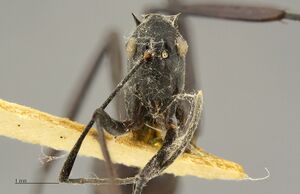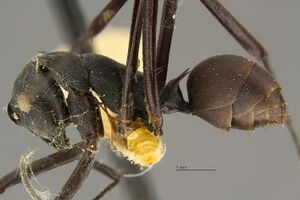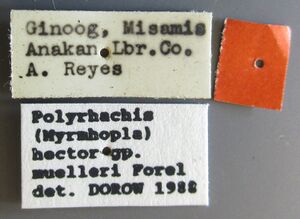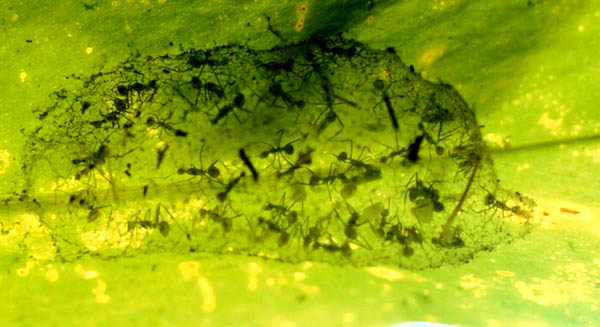Polyrhachis muelleri
| Polyrhachis muelleri | |
|---|---|

| |
| Scientific classification | |
| Kingdom: | Animalia |
| Phylum: | Arthropoda |
| Class: | Insecta |
| Order: | Hymenoptera |
| Family: | Formicidae |
| Subfamily: | Formicinae |
| Tribe: | Camponotini |
| Genus: | Polyrhachis |
| Subgenus: | Myrmhopla |
| Species: | P. muelleri |
| Binomial name | |
| Polyrhachis muelleri Forel, 1893 | |
A widely ranging forest species that uses larval silk to construct nests on the underside of leaves.
Identification
A member of the Polyrhachis hector species group.
Keys including this Species
Distribution
Kohout (2008) - Polyrhachis muelleri is a widespread species recorded from Thailand, Malaysia, Singapore, Borneo, Sumatra and Java.
Latitudinal Distribution Pattern
Latitudinal Range: 5.016666667° to -6.566666667°.
| North Temperate |
North Subtropical |
Tropical | South Subtropical |
South Temperate |
- Source: AntMaps
Distribution based on Regional Taxon Lists
Indo-Australian Region: Borneo, Indonesia, Malaysia, Philippines, Singapore (type locality).
Oriental Region: Thailand.
Distribution based on AntMaps
Distribution based on AntWeb specimens
Check data from AntWeb
Countries Occupied
| Number of countries occupied by this species based on AntWiki Regional Taxon Lists. In general, fewer countries occupied indicates a narrower range, while more countries indicates a more widespread species. |

|
Estimated Abundance
| Relative abundance based on number of AntMaps records per species (this species within the purple bar). Fewer records (to the left) indicates a less abundant/encountered species while more records (to the right) indicates more abundant/encountered species. |

|
Biology
The fairly transparent silk-woven nest of about 10 cm in length is situated beneath a leaf of a ginger plant about 2 m above ground, in a primary rainforest. Larvae and pupae appear greenish; only the adult ants are black and thus well visible against the sunlight.
The biology of P. muelleri was described in detail by Dorow et al. (1990). Colonies are monogynous with 17 workers on average (n=19)
Castes
Very slight difference in body size between queens and workers (Dorow et al. 1990)
Worker
   
| |
| . | Owned by Museum of Comparative Zoology. |
Nomenclature
The following information is derived from Barry Bolton's Online Catalogue of the Ants of the World.
- muelleri. Polyrhachis muelleri Forel, 1893c: 32 (w.) SINGAPORE. Forel, 1901d: 302 (q.m.); Wheeler, G.C. & Wheeler, J. 1990b: 754 (l.). Combination in P. (Myrmhopla): Emery, 1925b: 193.
Unless otherwise noted the text for the remainder of this section is reported from the publication that includes the original description.
Description
Type Material
Kohout (2008) - Syntype workers. SINGAPORE (A. Müller), Musee d'Histoire Naturelle Genève (examined).
References
- Dorow W.H.O., Maschwitz U.& Rapp S. 1990. The natural history of Polyrhachis (Myrmhopla) muelleri, a weaver ant with mimetic larvae and an unusual nesting behaviour, Tropical Zoology, 3:2, 181-190.
- Emery, C. 1925d. Hymenoptera. Fam. Formicidae. Subfam. Formicinae. Genera Insectorum 183: 1-302 (page 193, Combination in P. (Myrmhopla))
- Forel, A. 1893e. Les Formicides de l'Empire des Indes et de Ceylan. Part III. J. Bombay Nat. Hist. Soc. 8: 17-36 (page 32, worker described)
- Forel, A. 1901g. Einige neue Ameisen aus Südbrasilien, Java, Natal und Mossamedes. Mitt. Schweiz. Entomol. Ges. 10: 297-311 (page 302, queen, male described)
- Khachonpisitsak, S., Yamane, S., Sriwichai, P., Jaitrong, W. 2020. An updated checklist of the ants of Thailand (Hymenoptera, Formicidae). ZooKeys 998, 1–182 (doi:10.3897/zookeys.998.54902).
- Kohout, R.J. 2008a. A review of the Polyrhachis ants of Sulawesi with keys and descriptions of new species (Hymenoptera: Formicidae: Formicinae). Memoirs of the Queensland Museum. 52:255-317.
- Wheeler, G. C.; Wheeler, J. 1990b. Larvae of the formicine ant genus Polyrhachis. Trans. Am. Entomol. Soc. 116: 753-767 (page 754, larva described)
- Yamane, S., Tanaka, H.O., Hasimoto, Y., Ohashi, M., Meleng, P., Itioka, T. 2021. A list of ants from Lambir Hills National Park and its vicinity, with their biological information: Part II. Subfamilies Leptanillinae, Proceratiinae, Amblyoponinae, Ponerinae, Dorylinae, Dolichoderinae, Ectatomminae and Formicinae. Contributions from the Biological Laboratory, Kyoto University 31, 87–157.
References based on Global Ant Biodiversity Informatics
- Bolton, B. 1998. A preliminary analysis of the ants of the Pasoh Forest Reserve. Pp. 84-95 in: Lee, S. S.; Dan, Y. M.; Gauld, I. D.; Bishop, J. (eds.) Conservation, management and development of forest resources. Proceedings of the Malaysia-United Kingdom Programme Workshop 21-24 October 1996. Kuala Lumpur: International Institute for Environment and Development, 392 pp.: 84-95
- Chapman, J. W., and Capco, S. R. 1951. Check list of the ants (Hymenoptera: Formicidae) of Asia. Monogr. Inst. Sci. Technol. Manila 1: 1-327
- Dorow W. H. O., U. Maschwitz, and S. Rapp. 1990. The natural history of Polyrhachis (Myrmhopla) muelleri Forel 1893 (Formicidae: Formicinae), a weaver ant with mimetic larvae and an unusual nesting behavior. Tropical Zoology 3: 181-190.
- Dorow W. H. O., and U. Maschwitz. 1990. The arachne-group of Polyrhachis (Formicidae: Formicinae): weaver ants cultivating Homoptera on bamboo. Insectes Sociaux. 37: 73-89.
- Emery C. 1886. Saggio di un catalogo sistematico dei generi Camponotus, Polyrhachis e affini. Memorie della Reale Accademia delle Scienze dell'Istituto di Bologna 5: 363-382
- Emery C. Formiche raccolte da Elio Modigliani in Sumatra, Engano e Mentawei. Annali del Museo Civico di Storia Naturale 40: 661-722.
- Emery, C. "Formiche raccolte da Elio Modigliani in Sumatra, Engano e Mentawei." Annali del Museo Civico di Storia Naturale Giacomo Doria (Genova) (2) 20, no. 40 (1900): 661-722.
- Forel A. 1901. Einige neue Ameisen aus Südbrasilien, Java, Natal und Mossamedes. Mitteilungen der Schweizerischen Entomologischen Gesellschaft. 10: 297-311.
- Forel A. 1901. Einige neue Ameisen aus Südbrasilien, Java, Natal und Mossamedes. Mitt. Schweiz. Entomol. Ges. 10: 297-311.
- Kohout R.J., and M. Mohamed. 2008. A preliminary list of the Polyrhachis ants of the Maliau Basin Conservation area in Sabah, Borneo (Hymenoptera: Formicidae: Formicinae). Asian Myrmecology 2: 63-70.
- Kohout, R. J. 2008. A review of the Polyrhachis ants of Sulawesi with keys and descriptions of new species (Hymenoptera: Formicidae: Formicinae). Memoirs of the Queensland Museum 52:255-317.
- Pfeiffer M.; Mezger, D.; Hosoishi, S.; Bakhtiar, E. Y.; Kohout, R. J. 2011. The Formicidae of Borneo (Insecta: Hymenoptera): a preliminary species list. Asian Myrmecology 4:9-58
- Philpott S.M., P. Bichier, R.A. Rice, and R. Greenberg. 2008. Biodiversity conservation, yield, and alternative products in coffee agroecosystems in Sumatra, Indonesia. Biodivers. Conserv. 17: 1805-1820. Data obtained from Stacy Philpott
- Robson Simon Database Polyrhachis -05 Sept 2014


